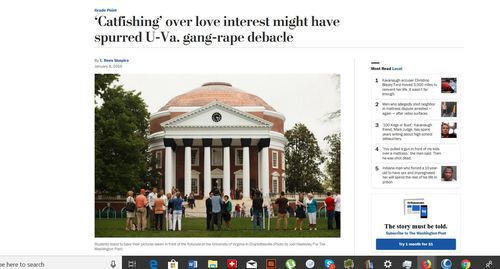


01/09/2016
From the Washington Post:
A lot of effort has been put into stuffing the UVA — Rolling Stone gang rape on broken glass hate hoax down the Memory Hole by making the scandal seem as boring and technical as imaginable: mistakes were made in following proper journalistic procedures. Nothing else to remember here, move along.‘Catfishing’ over love interest might have spurred U-Va. gang-rape debacle
According to text messages in new court documents, one student was aggressively pursuing a romantic relationship but had been rebuffed just ahead of now-discounted rape allegations.
The key roadblock was to keep the words “catfishing” and “Haven Monahan” out of the public mind. If you understand how those two fit together, the story is hilarious: a super-girly girl, Jackie, catfishes a dream date “Haven Monahan” into digital existence to make a boy she likes, Ryan, jealous.
When that’s not working she makes up a story about Haven Monahan’s sexual assault. When that still doesn’t make Ryan fall in love with her, she switches back to having Haven send Ryan an email explaining why Ryan should fall in love with Jackie, cribbed from Dawson’s Creek and other romance shows for boy-crazy tween girls.
When that fails, Jackie slowly becomes aware over many months that if she can’t have Ryan, she can still have some of the attention she craves by portraying herself as a victim of campus rape culture. But of course she can’t call the police because she just made everything up. Dean Nicole Eramo recognizes that Jackie’s probably never going to talk to the police about her woozy story.
Eventually, Sabrina Rubin Erdely comes to town for Rolling Stone and between them they work up a doozy of a story. With publication, an actual Night of Broken Glass ensues with SJW vandals smashing the windows of the libeled fraternity house. Jackie then defends Dean Eramo when America’s feminists try to get the poor woman fired. It’s a complete fiasco, but nobody in the media seems to notice that Erdely’s article is absurd until Richard Bradley blogs about it five days later. After four more days, I post a link to Bradley’s blog and the great unraveling begins.
A week and a half later, Shapiro publishes a long article in the Washington Post that lays out many facts (although not yet the name Haven Monahan), but requires a very high reading comprehension level to extract the details and arrange them into an interesting story. (That’s not unusual in a case where a reporter has gotten a scoop under deadline pressure with legal and ideological worries.)
That evening in December 2014, a legendary comedy writer called me out of the blue to talk over the question: Is this Washington Post article actually as hilarious as it appears to me if I boiled it down?
Yes, it is.
But most of the news media never really grasps these later developments in the story that make it so vivid. The NYT, in particular, is extremely reluctant to mention the whole catfishing / Dawson’s Creek angle.
Fortunately, the ongoing lawsuits have allowed Shapiro to return to the story and use the megaphone of the Washington Post to finally start to craft a more memorable public image of this highly representative tale of our age.